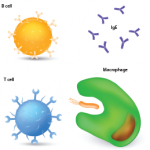They noted that the peripheral naive B cells and the ASCs appear to persist for a long time in patients with SLE.
The investigators conclude by suggesting that their data may facilitate the design of better therapies for SLE. Moreover, “Our study provides an immunological explanation for the clinical benefit of belimumab (antibody to B cell activation factor) and epratuzumab (anti-CD22), which ‘preferentially’ affect acN cells,” they explain.
ad goes here:advert-1
ADVERTISEMENT
SCROLL TO CONTINUE
Lara C. Pullen, PhD, is a medical writer based in the Chicago area.
References
ad goes here:advert-2
ADVERTISEMENT
SCROLL TO CONTINUE
- Tipton CM, Fucile CF, Darce J, et al. Diversity, cellular origin and autoreactivity of antibody-secreting cell population expansions in acute systemic lupus erythematosus. 25 May 2015. Nature Immunol. doi:10.1038/ni.3175
